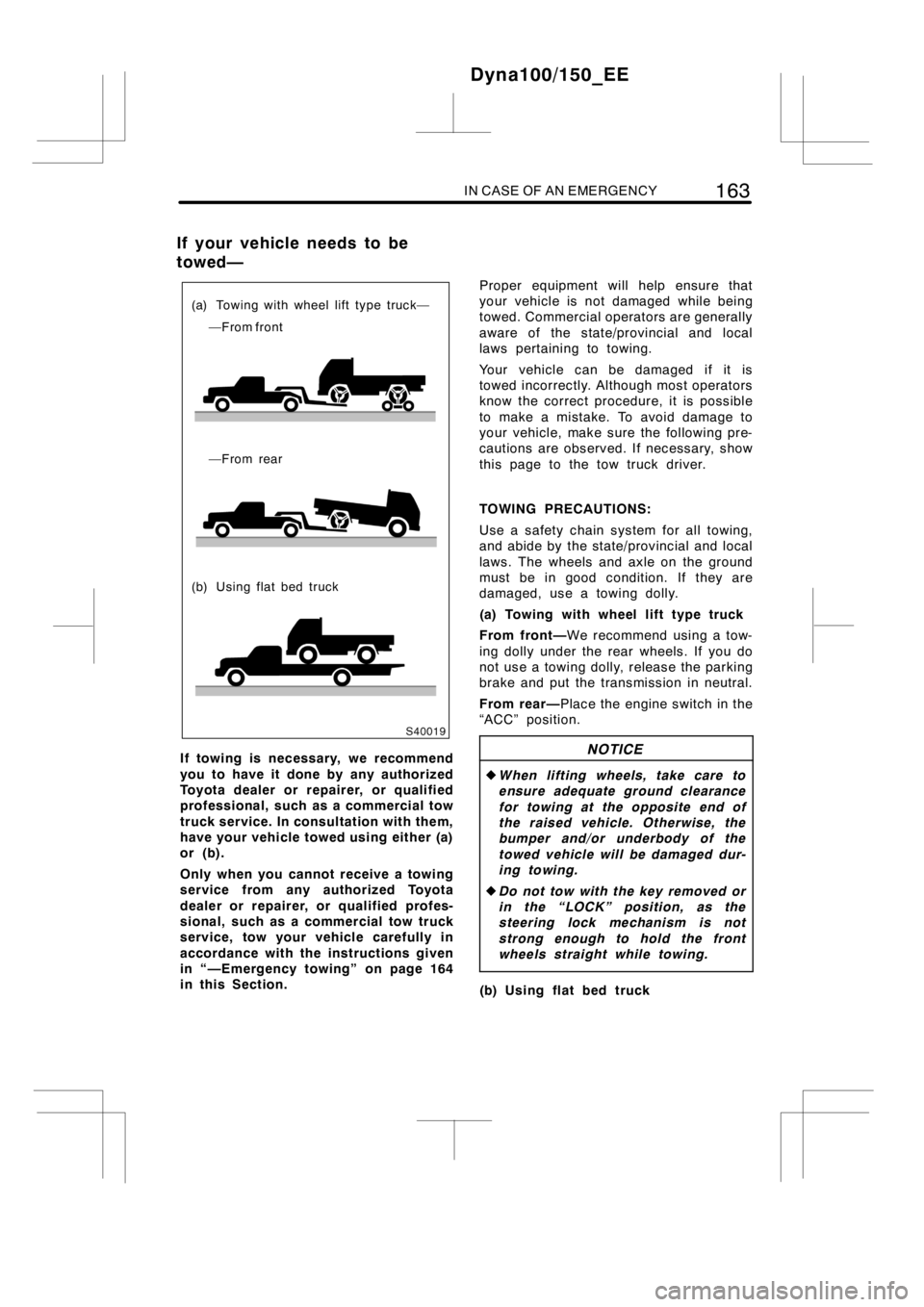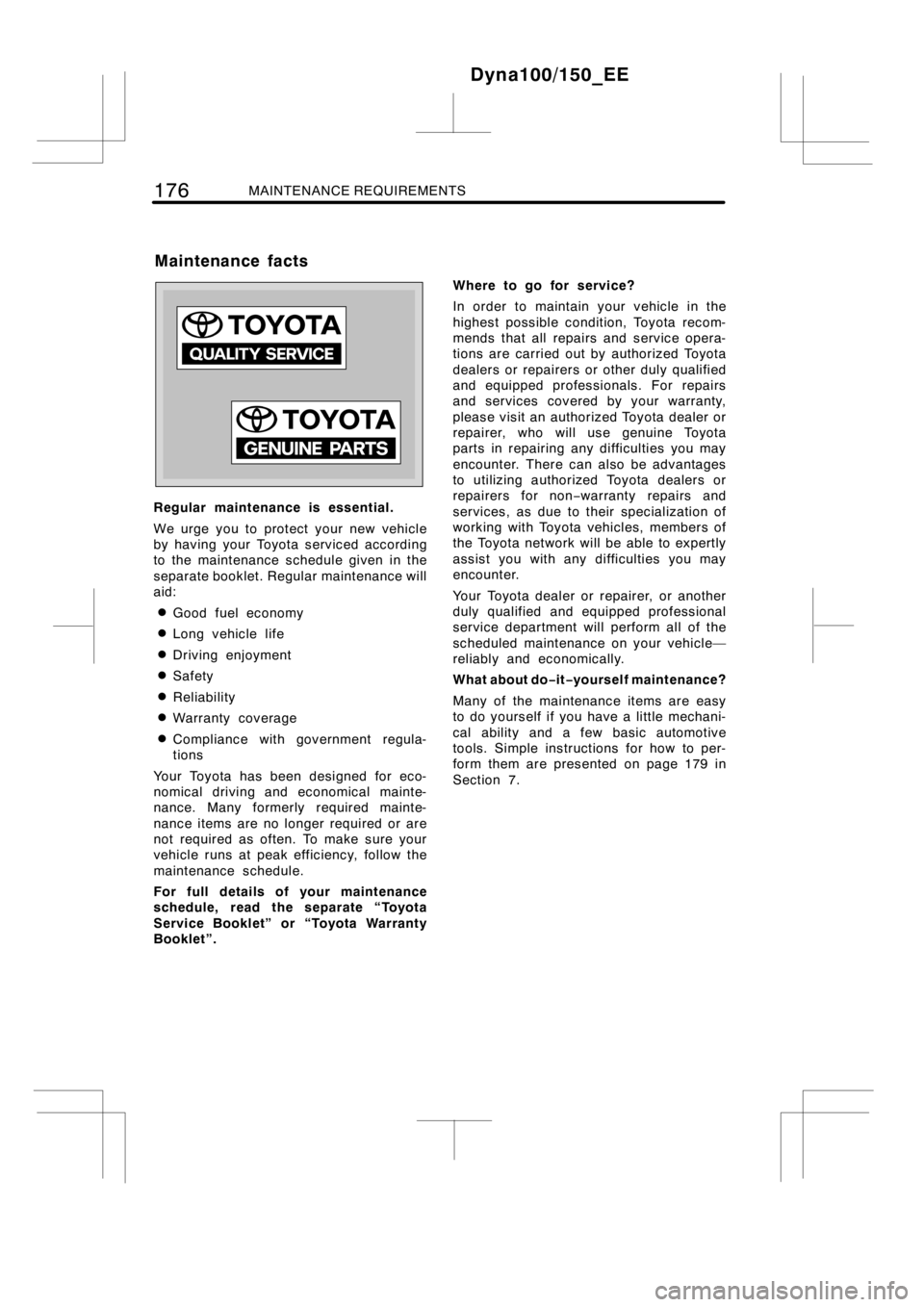2014 TOYOTA DYNA 100/150 air condition
[x] Cancel search: air conditionPage 154 of 232

148IN CASE OF AN EMERGENCY
If your engine coolant temperature
gauge indicates overheating, if you ex-
perience a loss of power, or if you hear
a loud knocking or pinging noise, the
engine has probably overheated. You
should follow this procedure...
1. Pull safely off the road, stop the ve-
hicle, and turn on your emergency
flashers. Put the transmission in neu-
tral and apply the parking brake. Turn
off the air conditioning if it is being
used.
2. If coolant or steam is boiling out of the
radiator or reservoir, stop the engine.
Wait until the steam subsides before
opening the engine access hole cover
or tilting the cab. If there is no coolant
or steam boiling over, leave the engine
running and make sure the electric
cooling fan is operating. If it is not,
turn the engine switch off.
CAUTION
To help avoid serious injury, keep the
engine access hole cover closed or
the cab lowered until there is no
steam. Escaping steam or coolant is
a sign of very high pressure.
3. Visually check to see if the engine
drive belt (fan belt) is broken or loose.
Look for obvious coolant leaks from the
radiator, hoses, and under the vehicle.
However, note that water draining from
the air conditioning is normal if it has
been used.
CAUTION
When the engine is running, keep
hands and clothing away from the
moving fan and engine drive belts.
4. If the engine drive belt is broken or the
coolant is leaking, stop the engine im-
mediately. Call any authorized Toyota
dealer or repairer, or another duly qual-
ified and equipped professional, for as-
sistance.
5. If the engine drive belt is O.K. and
there are no obvious leaks, you may
help the engine cool down more quickly
by running it at about 1500 rpm for a
few minutes with the accelerator pedal
lightly depressed.
6. Check the coolant reservoir. If it is dry,
add coolant to the reservoir while the
engine is running. Fill it about half full.
For the coolant type, see “Coolant type
selection” on page 191 in Section 7−2.
CAUTION
Do not attempt to remove the radiator
cap when the engine and radiator are
hot. Serious injury could result from
scalding hot fluid and steam blown
out under pressure.
7. After the engine coolant temperature
has cooled to normal, again check the
coolant level in the reservoir. If neces-
sary, bring it up to half full again.
Serious coolant loss indicates a leak in
the system. You should have it
checked as soon as possible at any
authorized Toyota dealer or repairer, or
another duly qualified and equipped
professional.
Dyna100/150_EE
If your vehicle overheats
Page 169 of 232

IN CASE OF AN EMERGENCY163
(a) Towing with wheel lift type truck—
—From front
—From rear
(b) Using flat bed truck
If towing is necessary, we recommend
you to have it done by any authorized
Toyota dealer or repairer, or qualified
professional, such as a commercial tow
truck service. In consultation with them,
have your vehicle towed using either (a)
or (b).
Only when you cannot receive a towing
service from any authorized Toyota
dealer or repairer, or qualified profes-
sional, such as a commercial tow truck
service, tow your vehicle carefully in
accordance with the instructions given
in “—Emergency towing” on page 164
in this Section.Proper equipment will help ensure that
your vehicle is not damaged while being
towed. Commercial operators are generally
aware of the state/provincial and local
laws pertaining to towing.
Your vehicle can be damaged if it is
towed incorrectly. Although most operators
know the correct procedure, it is possible
to make a mistake. To avoid damage to
your vehicle, make sure the following pre-
cautions are observed. If necessary, show
this page to the tow truck driver.
TOWING PRECAUTIONS:
Use a safety chain system for all towing,
and abide by the state/provincial and local
laws. The wheels and axle on the ground
must be in good condition. If they are
damaged, use a towing dolly.
(a) Towing with wheel lift type truck
From front—We recommend using a tow-
ing dolly under the rear wheels. If you do
not use a towing dolly, release the parking
brake and put the transmission in neutral.
From rear—Place the engine switch in the
“ACC” position.NOTICE
zWhen lifting wheels, take care to
ensure adequate ground clearance
for towing at the opposite end of
the raised vehicle. Otherwise, the
bumper and/or underbody of the
towed vehicle will be damaged dur-
ing towing.
zDo not tow with the key removed or
in the “LOCK” position, as the
steering lock mechanism is not
strong enough to hold the front
wheels straight while towing.
(b) Using flat bed truck
Dyna100/150_EE
If your vehicle needs to be
towed—
Page 171 of 232

IN CASE OF AN EMERGENCY165
If towing is necessary, we recommend
you to have it done by any authorized
Toyota dealer or repairer, or qualified
professional, such as a commercial tow
truck service.
If towing service is not available in an
emergency, your vehicle may be tempo-
rarily towed by a cable or chain se-
cured to one of the following parts:
Front: Front emergency towing hook
Rear: Rear emergency towing eyelet
Use extreme caution when towing the
vehicle.
NOTICE
Only use specified towing hook or
eyelet; otherwise your vehicle may be
damaged.
A driver must be in the vehicle to steer
it and operate the brakes.
Towing in this manner may be done only
on hard−surfaced roads for a short dis-
tance and at low speeds. Also, the
wheels, axles, drive train, steering and
brakes must all be in good condition.
CAUTION
Use extreme caution when towing the
vehicle. Avoid sudden starts or errat-
ic driving maneuvers which would
place excessive stress on the emer-
gency towing hook or eyelet and tow-
ing cable or chain. The hook or eye-
let and towing cable or chain may
break and cause serious injury or
damage.
NOTICE
Use only a cable or chain specifically
intended for use in towing vehicles.
Securely fasten the cable or chain to
the towing hook or eyelet provided.
Before towing, release the parking brake
and put the transmission in neutral. The
engine switch must be in “ACC” (engine
off) or “ON” (engine running) position.
CAUTION
If the engine is not running, the pow-
er assist for the brakes and steering
will not work so steering and braking
will be much harder than usual.
Dyna100/150_EE
Page 176 of 232

170CORROSION PREVENTION AND APPEARANCE CARE
Toyota, through the diligent research, de-
sign and use of the most advanced
technology available, helps prevent corro-
sion and provides you with the finest qual-
ity vehicle construction. Now, it is up to
you. Proper care of your Toyota can help
ensure long−term corrosion prevention.
The most common causes of corrosion
to your vehicle are:
DThe accumulation of road salt, dirt and
moisture in hard−to−reach areas under
the vehicle.
DChipping of paint, or undercoating
caused by minor accidents or by
stones and gravel.
Care is especially important if you live
in particular areas or operate your ve-
hicle under certain environmental condi-
tions:
DRoad salt or dust control chemicals will
accelerate corrosion, as will the pres-
ence of salt in the air near the sea−
coast or in areas of industrial pollution.
DHigh humidity accelerates corrosion es-
pecially when temperatures range just
above the freezing point.
DWetness or dampness to certain parts
of your vehicle for an extended period
of time, may cause corrosion even
though other parts of the vehicle may
be dry.
DHigh ambient temperatures can cause
corrosion to those components of the
vehicle which do not dry quickly due to
lack of proper ventilation.
The above signifies the necessity to keep
your vehicle, particularly the underside, as
clean as possible and to repair any dam-
age to paint or protective coatings as
soon as possible.To help prevent corrosion on your
Toyota, follow these guidelines:
Wash your vehicle frequently.It is, of
course, necessary to keep your vehicle
clean by regular washing, but to prevent
corrosion, the following points should be
observed:
DIf you drive on salted roads in the
winter or if you live near the ocean,
you should hose off the undercarriage
at least once a month to minimize cor-
rosion.
DHigh pressure water or steam is effec-
tive for cleaning the vehicle’s underside
and wheel housings. Pay particular
attention to these areas as it is difficult
to see all the mud and dirt. It will do
more harm than good to simply wet the
mud and debris without removing. The
lower edge of doors, rocker panels and
frame members have drain holes which
should not be allowed to clog with dirt
as trapped water in these areas can
cause corrosion.
DWash the underside of the vehicle thor-
oughly when winter is over.
See “Washing and waxing your Toyota” on
page 171 for more tips.
Check the condition of your vehicle’s
paint and trim.If you find any chips or
scratches in the paint, touch them up im-
mediately to prevent corrosion from start-
ing. If the chips or scratches have gone
through the bare metal, have a qualified
body shop make the repair.
Check the interior of your vehicle.Wa-
ter and dirt can accumulate under the
floor mats and could cause corrosion. Oc-
casionally check under the mats to make
sure the area is dry. Be particularly care-
ful when transporting chemicals, cleans-
ers, fertilizers, salt, etc.; these should be
transported in proper containers. If a spill
or leak should occur, immediately clean
and dry the area.
Dyna100/150_EE
Protecting your Toyota from
corrosion
Page 180 of 232

174CORROSION PREVENTION AND APPEARANCE CARE
Air conditioning control panel, audio
panel, instrument panel, console panel,
door switch panels, and switches
Use a soft damp cloth for cleaning.
Soak a clean soft cloth in water or luke-
warm water then lightly wipe off dirt.
NOTICE
zDo not use organic substances (sol-
vents, kerosene, alcohol, gasoline,
etc.) or alkaline or acidic solutions.
These chemicals can cause discol-
oring, staining or peeling of the
surface.
zIf you use cleaners or polishing
agents, make sure their ingredients
do not include the substances men-
tioned above.
zIf you use a liquid car freshener, do
not spill the liquid onto the ve-
hicle’s interior surfaces. It may con-
tain the ingredients mentioned
above. Immediately clean any spill
using the method mentioned above.
If you have any questions about the
cleaning of your Toyota, any authorized
Toyota dealer or repairer, or another
duly qualified and equipped profession-
al, will be pleased to answer them.
Dyna100/150_EE
Page 182 of 232

176MAINTENANCE REQUIREMENTS
Regular maintenance is essential.
We urge you to protect your new vehicle
by having your Toyota serviced according
to the maintenance schedule given in the
separate booklet. Regular maintenance will
aid:
DGood fuel economy
DLong vehicle life
DDriving enjoyment
DSafety
DReliability
DWarranty coverage
DCompliance with government regula-
tions
Your Toyota has been designed for eco-
nomical driving and economical mainte-
nance. Many formerly required mainte-
nance items are no longer required or are
not required as often. To make sure your
vehicle runs at peak efficiency, follow the
maintenance schedule.
For full details of your maintenance
schedule, read the separate “Toyota
Service Booklet” or “Toyota Warranty
Booklet”.Where to go for service?
In order to maintain your vehicle in the
highest possible condition, Toyota recom-
mends that all repairs and service opera-
tions are carried out by authorized Toyota
dealers or repairers or other duly qualified
and equipped professionals. For repairs
and services covered by your warranty,
please visit an authorized Toyota dealer or
repairer, who will use genuine Toyota
parts in repairing any difficulties you may
encounter. There can also be advantages
to utilizing authorized Toyota dealers or
repairers for non−warranty repairs and
services, as due to their specialization of
working with Toyota vehicles, members of
the Toyota network will be able to expertly
assist you with any difficulties you may
encounter.
Your Toyota dealer or repairer, or another
duly qualified and equipped professional
service department will perform all of the
scheduled maintenance on your vehicle—
reliably and economically.
What about do−it−yourself maintenance?
Many of the maintenance items are easy
to do yourself if you have a little mechani-
cal ability and a few basic automotive
tools. Simple instructions for how to per-
form them are presented on page 179 in
Section 7.
Dyna100/150_EE
Maintenance facts
Page 183 of 232

MAINTENANCE REQUIREMENTS177
Note, however, that some maintenance
tasks require special tools and skills.
These are best performed by qualified
technicians. Even if you’re an experienced
do−it−yourself mechanic, we recommend
that repairs and maintenance be con-
ducted by an authorized Toyota dealer or
repairer, or another duly qualified and
equipped professional. Any authorized
Toyota dealer or repairer will keep a
record of maintenance, which could be
useful should you ever require Warranty
Service. Should you choose to select a
qualified and equipped professional other
than an authorized Toyota repairer to
service or maintain your vehicle, we
recommend that you request that a record
of maintenance be kept.
The service interval for scheduled main-
tenance is determined by the odometer
reading or time interval, whichever
comes first, shown in the schedule.
Rubber hoses (for cooling and heater
system, brake system and fuel system)
should be inspected by a qualified tech-
nician in accordance with the Toyota
maintenance schedule.
They are particularly important mainte-
nance items. Have any deteriorated or
damaged hoses replaced immediately.
Note that rubber hoses will deteriorate
with age, resulting in swelling, chafing or
cracks.Be on the alert for changes in perfor-
mance, sounds, and visual tip−offs that
indicate service is needed. Some impor-
tant clues are as follows:
DEngine missing, stumbling, or pinging
DAppreciable loss of power
DStrange engine noises
DA leak under the vehicle (However, wa-
ter dripping from the air conditioning
after use is normal.)
DChange in exhaust sound (This may
indicate a dangerous carbon monoxide
leak. Drive with the windows open and
have the exhaustsystem checked im-
mediately.)
DFlat−looking tire; excessive tire squeal
when cornering; uneven tire wear
DVehicle pulls to one side when driving
straight on a level road
DStrange noises related to suspension
movement
DLoss of brake effectiveness; spongy
feeling brake or clutch pedal; pedal al-
most touches floor; vehicle pulls to one
side when braking
DEngine coolant temperature continually
higher than normal
If you notice any of these clues, take your
vehicle to any authorized Toyota dealer or
repairer, or another duly qualified and
equipped professional, as soon as pos-
sible. It probably needs adjustment or re-
pair.
CAUTION
Do not continue driving with the ve-
hicle unchecked. It could result in se-
rious vehicle damage and possibly se-
rious injury.
Dyna100/150_EE
Does your vehicle need
repairing?
Page 191 of 232

DO−IT−YOURSELF MAINTENANCE: Introduction185
If you perform maintenance by yourself,
be sure to follow the correct procedure
given in this Section.
You should be aware that improper or in-
complete servicing may result in operating
problems.
This Section gives instructions only for
those items that are relatively easy for an
owner to perform. As explained in Section
6, there are still a number of items that
must be done by a qualified technician
with special tools.
Utmost care should be taken when work-
ing on your vehicle to prevent accidental
injury. Here are a few precautions that
you should be especially careful to ob-
serve:
CAUTION
DWhen the engine is running, keep
hands, clothing, and tools away
from the moving fan and engine
drive belts. (Removing rings,
watches, and ties is advisable.)
DRight after driving, the engine
compartment—the engine, radiator,
exhaust manifold and power steer-
ing fluid reservoir, etc.—will be hot.
So be careful not to touch them.
Oil and fluids may also be hot.
DIf the engine is hot, do not remove
the radiator cap or loosen the drain
plugs to prevent burning yourself.
DDo not leave anything that may
burn easily, such as paper or rags,
in the engine compartment.
DDo not smoke, cause sparks or al-
low open flames around fuel or the
battery. Their fumes are flammable.
DBe extremely cautious when work-
ing on the battery. It contains poi-
sonous and corrosive sulfuric acid.
DDo not get under your vehicle with
just the body jack supporting it. Al-
ways use automotive jack stands or
other solid supports.
DBe sure that the engine switch is
off if you work near the electric
cooling fans. With the engine
switch on, the electric cooling fans
will automatically start to run if the
engine coolant temperature is high
and/or the air conditioning is on.
DUse eye protection whenever you
work on or under your vehicle
where you may be exposed to flying
or falling material, fluid spray, etc.
DUsed engine oil contains potentially
harmful contaminants which may
cause skin disorders such as in-
flammation or skin cancer, so care
should be taken to avoid prolonged
and repeated contact with it. To re-
move used engine oil from your
skin, wash thoroughly with soap
and water.
DDo not leave used oil within the
reach of children.
DDispose of used oil and filter only
in a safe and acceptable manner.
Do not dispose of used oil and fil-
ter in household trash, in sewers or
onto the ground. Call your dealer or
a service station for information
concerning recycling or disposal.
DTake care when filling the brake and
clutch fluid reservoirs because
brake fluid can harm your hands or
eyes. If fluid gets on your hands or
in your eyes, flush the affected area
with clean water immediately. If you
still feel uncomfortable with your
hands or eyes, go to the doctor.
Dyna100/150_EE
Do−it−yourself service
precautions